A brief introduction to the origin, development, history and culture of boutique coffee beans in the elegant and charming Manor Erida in Panama.

In addition to creating good conditions for coffee cultivation, the Lamastus family, which runs Elida Estate, has planted many different native tree species on the estate, not only to shade the coffee trees, but also to provide a friendly habitat for birds. In terms of fertilization, Lamastus family uses artificial fertilization and small amounts of chemical fertilizers, but never pesticides and herbicides harmful to the environment.
In addition to Catuai, Typica and Bourbon, the Lamastus family also began planting Geisha varieties a few years ago. Despite this, Elida Estate's batches participating in the Best of Panama competition all use Catuai species, but they can still achieve good results repeatedly, which shows that their geographical environment and excellent post-harvest processing technology bring excellent quality and special flavor to coffee.
This batch of green beans was obtained by sun treatment rare in Central America-dark red to purple berries artificially harvested at peak maturity and exposed to direct sunlight for more than two weeks. The berry pulp sugar and the sun microbial fermentation products, all concentrated and integrated into the coffee beans, giving this rare sun-cured version of high-altitude Panama coffee a rich dry aroma of strawberries, cream, toast, and coffee into the mouth into rich berries and tropical fruits mixed with vanilla, mint cool grass flavor, complex aroma, fruity elegant charm, sweet and sour, pleasant taste, is a rare delicious combination
In November 1903, the United States instigated Pakistan to secede from Colombia and establish the Republic of Panama. On November 18, the United States and Pakistan signed the Panama Canal Treaty. The United States obtained the right to "permanently use, occupy and control the Panama Canal." Subsequently, it controlled the administration, justice, police, railways and finance of the Yunhe District, making the Yunhe District a veritable "country within a country." The treaty remained the subject of diplomatic wrangling between the two countries until 1977, when the United States agreed to return control of the canal to Panama in 1999.
General Omar Torrijos came to power in 1968 and was the de facto ruler of Panamanian politics until his death in an air crash. After Torrijos died, Manuel Noriega assumed power.
On September 7, 1977, the governments of the United States and Panama signed a new treaty on the Panama Canal. The new treaty stipulates that the United States will gradually return full sovereignty and jurisdiction over the Canal and Yunhe District to Panama by the end of 1999.
In the May 1989 presidential election, Guillermo Endara won the election, but Noriega declared the election invalid. In September of the same year, the United States imposed economic sanctions on Pakistan. In December 1989, a U.S. Marine was killed and the United States invaded Panama to protect the safety of American residents. On December 15, Noriega declared a state of war with the United States and became head of state.
On December 20, 27,000 U.S. troops launched a military operation against Panama to overthrow Noriega's regime and Ndara became president. Noriega escaped to the Vatican embassy and surrendered to the U.S. military on January 3, 1990. He was immediately transported to Florida, charged and imprisoned. The U.S. invasion killed about 2,000 people, including Panamanian soldiers and civilians.
On December 31, 1999, Panama regained full management and defense rights of the Canal and all US troops withdrew.
Elida Manor is located in the Poquet producing area of the western border province of Panama-Chery. The most famous landmark and tourist attraction of the province is the Baru volcano at an altitude of 3300 meters. Baru volcano is one of the highest volcanoes in Central America, with a total area of about 14000 hectares. It can be divided into 7 different microclimate zones according to altitude. There are many rare plants, birds and mammals inhabiting in the volcanic range. The Poquet producing area is located on the east side of Baru volcano. It is a valley area where volcanic lava flows, adjacent to the Volcan Valley, another famous coffee producing area in Panama.
Boquet is Panama's most popular coffee producer, with many famous estates-such as the Emerald Estate, famous for its Geisha variety.(Esmeralda), Best of Panama Hartman, Mamakata (Mama Cata), Kotowa Estate, Santa Teresa Estate, etc., and Elida Estate itself is also a heavyweight star estate in the Boquet region-winning the Best of Panama award for the past five years in a row, second only to Emerald Estate. Elida Estate has a total area of 65 hectares, more than half of which are located within the Baru Volcano National Park, 30 hectares of which are planted with coffee trees and the remaining 35 hectares are virgin forests. Coffee is grown at altitudes ranging from 1670 to 1850 meters, making it one of the two highest coffee estates in Panama (the other one at this altitude would be Carmen Estate in the Vulcan Valley). At this altitude, the low temperature delays the ripening of coffee berries by about a month, while the fertile volcanic loam provides sufficient nutrients for coffee, and the excellent microclimate brought by Baru volcano enables Elida Manor to repeatedly win cup tests. In addition to creating good conditions for coffee cultivation, the Lamastus family, which runs Elida Estate, has planted many different native tree species on the estate, not only to shade the coffee trees, but also to provide a friendly habitat for birds. In terms of fertilization, Lamastus family uses artificial fertilization and small amounts of chemical fertilizers, but never pesticides and herbicides harmful to the environment. In addition to Catuai, Typica and Bourbon, the Lamastus family also began planting Geisha varieties a few years ago. Despite this, Elida Estate's batches participating in the Best of Panama competition all use Catuai species, but they can still achieve good results repeatedly, which shows that their geographical environment and excellent post-harvest processing technology bring excellent quality and special flavor to coffee.
Boquet is Panama's most popular coffee producer, with many famous estates-such as the Emerald Estate, famous for its Geisha variety.(Esmeralda), Best of Panama Hartman, Mamakata (Mama Cata), Kotowa Estate, Santa Teresa Estate, etc., and Elida Estate itself is also a heavyweight star estate in the Boquet region-winning the Best of Panama award for the past five years in a row, second only to Emerald Estate.
Elida Estate has a total area of 65 hectares, more than half of which are located within the Baru Volcano National Park, 30 hectares of which are planted with coffee trees and the remaining 35 hectares are virgin forests.
Coffee is grown at altitudes ranging from 1670 to 1850 meters, making it one of the two highest coffee estates in Panama (the other one at this altitude would be Carmen Estate in the Vulcan Valley).
At this altitude, the low temperature delays the ripening of coffee berries by about a month, while the fertile volcanic loam provides sufficient nutrients for coffee, and the excellent microclimate brought by Baru volcano enables Elida Manor to repeatedly win cup tests.
Important Notice :
前街咖啡 FrontStreet Coffee has moved to new addredd:
FrontStreet Coffee Address: 315,Donghua East Road,GuangZhou
Tel:020 38364473
- Prev

A brief introduction to the flavor, taste and aroma characteristics of boutique coffee beans in the aroma-rich Manor Erida in Panama
Poquet Lelida Manor Coffee in Panama Macedonia has always preferred the strong taste of African beans, and the Central American beans in my impression seem to be synonymous with moderates, whether in Costa Rica or Guatemala. Island coffee in the Caribbean is synonymous with fruit juice. And this Panama did give me a pleasant surprise, refreshing fruit acid is obviously better than other countries in China and the United States.
- Next

A brief introduction to the Market Price of Fine Coffee Bean varieties in Manor Erida, Panama
Hartman Manor is located in Chilidge, Santa Clara. The founder's name is Ellis Strauss Hartman. He was born on June 20, 1891 in the Moravilla region of Austria and Hungary in what is now the Czech Republic, and died on May 25, 1970 at the age of 78. Today's Hartman Manor is a family business, which was dialed by Ratti Hartman (son of Eloise) in 19.
Related
- Does Rose Summer choose Blue, Green or Red? Detailed explanation of Rose Summer Coffee plots and Classification in Panamanian Jade Manor
- What is the difference between the origin, producing area, processing plant, cooperative and manor of coffee beans?
- How fine does the espresso powder fit? how to grind the espresso?
- Sca coffee roasting degree color card coffee roasting degree 8 roasting color values what do you mean?
- The practice of lattes: how to make lattes at home
- Introduction to Indonesian Fine Coffee beans-- Java Coffee producing area of Indonesian Arabica Coffee
- How much will the flavor of light and medium roasted rose summer be expressed? What baking level is rose summer suitable for?
- Introduction to the characteristics of washing, sun-drying or wet-planing coffee commonly used in Mantenin, Indonesia
- Price characteristics of Arabica Coffee Bean Starbucks introduction to Manning Coffee Bean Taste producing area Variety Manor
- What is the authentic Yega flavor? What are the flavor characteristics of the really excellent Yejasuffi coffee beans?

